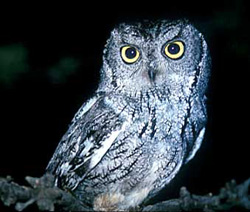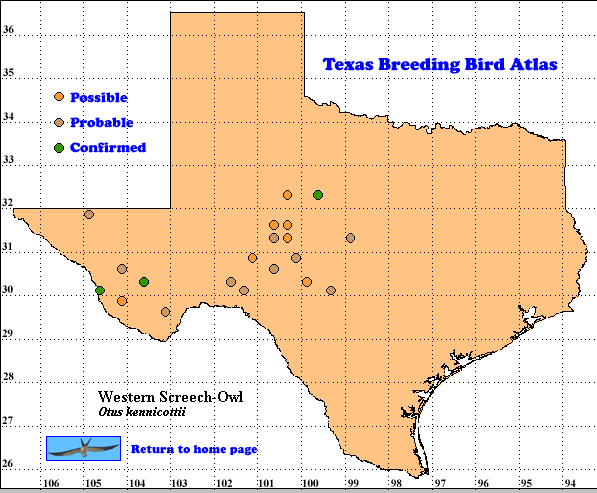Otus Kennicottii
Western Screech-Owls are permanent residents from southeastern Alaska to the Trans-Volcanic Region of Mexico, and from the western Rocky Mountains and Central Plateau in Mexico, west of the Sierra Madre Oriental, to the Pacific Coast except south coastal Mexico (Gehlbach 2002a). They inhabit a variety of woodlands, forests, and arboreal cactus deserts but are focused in riverside and arroyo woods in desert and prairie areas. They occur to about 2275 m (7500 ft) elevation in mountain canyons (Miller 1955, Gehlbach 1981, Wauer 1996). Like Eastern Screech Owls (O. asio), they do well in cities with suitable mature trees and cavities.
TEXAS DISTRIBUTION: Western Screech-Owls breed throughout the Trans-Pecos and eastward on the Stockton and western Edwards plateaus, overlapping Eastern Screech-Owls from eastern Presidio to western Kerr counties (west to east) and from Tom Green to Kinney and Uvalde counties (north to south; Gehlbach 1995, 2002a). O. a. aikeni is in Parmer County in the western Panhandle (Rylander 2001) and otherwise occurs only in the Guadalupe Mountains. O. k. suttoni (and intergrades with aikeni) lives elsewhere and is expanding eastward, possibly aided by restoration and protection of riparian habitat (Gehlbach 2002a).
ABUNDANCE: Nesting pairs at 1575 m (5200 ft) in McKittrick Canyon, Guadalupe Mountains, Culberson County, averaged 1/km2 (2 mi2) in 1960-1963, similar to those at the same elevation in wooded canyons of southeastern Arizona (pers. observ.). In 1973-75 along the Devil’s River, Val Verde County, Western Screech-Owls averaged 0.5 nesting pairs/km2 (0.8/mi2) compared to twice as many Eastern Screech-Owls. A suburban El Paso population in a very disturbed, remnant floodplain forest of the Rio Grande was 1 pair/km2 (2/mi2) in 1998-99 (pers. observ.).
Western Screech-Owls may be difficult to detect at low densities, since Burleigh and Lowery (1940) did not record them in the Guadalupe Mountains, although Bailey (1928) did. Also, Newman (1979) did not record them there in 1972-74, whereas I did in 1954-63 and again at various times in the l980s and ’90s. Normally, however, they are much more abundant that Eastern Screech-Owls where the two overlap west of the Pecos River.
SEASONALITY: Egg laying occurs March 12 in lowlands of the Big Bend (Wauer 1996) with incubation to May 25 in the mountains (Van Tyne and Sutton 1937). Records of nestlings are May 11-June 23 and of fledglings June 10-July 9, the latter at about 2120 m (7000 ft) in the Chisos Mountains (Wauer 1996, TBBA records). Dependent fledglings were observed June 15 at 1515 m (5000 ft.) in the Guadalupe Mountains (pers. observ.). Thus, nesting chronology resembles that of the Eastern Screech-Owl but may be later at high elevations because of cooler temperatures.
BREEDING HABITAT: Most moderate to dense woodlands and forests, including streamside woods in deserts and prairies, are suitable if tree cavities are available. Nests in Texas’ riveredge woodlands and mountain forests have been in cottonwoods, willows, sycamores, and oaks in cottonwood-willow, cottonwood-sycamore, live oak-pecan, live oak-mesquite, and pine-oak-juniper associations (Van Tyne and Sutton 1937, Wauer 1996, pers. observ.). Habitat tends to be dryer or somewhat higher in elevation than that of coexisting Eastern Screech-Owls (Gehlbach 1995, 2002a; Lockwood 2001).
Nest cavities are damaged places in tree trunks and limbs, caused by storms, rotting, and, squirrels. Old woodpecker holes are also used, especially those of Northern Flickers (Colaptes auratus). Nest boxes are readily accepted, but the use of other kinds of cultural substitutes is not known in Texas. Like all North American cavity-nesting owls, eggs are laid on whatever material is present at the bottom of the cavity.
STATUS: Most pre-1980s accounts combined Western with Eastern screech-owls, so status changes are difficult to assess, although Marshall (l967) recognized and mapped salient differences in the Big Bend region. There he found interbreeding pairs of Western and Eastern screech-owls in 1963 as did Gehlbach (1981) in 1973 (see Eastern Screech-Owl). Hybridization may be caused by the scarcity of conspecific mates and vocal mimicry. Where they overlap, both species sing each other’s songs, a territorial spacing feature that may inadvertently cause hybridization where mates are scarce (Gehlbach 2002a).
East of the Pecos River, Marshall (1967) mapped a record at Juno, Val Verde County. Western Screech-Owls lived along the Concho River, Tom Green County, in the 1960-70s (C. Wiedenfeld, pers. comm.; also Devil’s River as noted above) but did not occur as far east as Kerr County, where they appeared by l985 (Grzybowski 1985)). The present survey found 14 localities east of the Pecos River. Western Screech-Owls have expanded eastward across the Pecos but perhaps more recently or in smaller numbers on the Edwards Plateau than the westward expansion of Eastern Screech-Owls, since Westerns seem to be rarer locally and more scattered eastward.
Text by Frederick R. Gehlbach
(ca. 2002)
Literature cited
Gehlbach, F. R. 2002a. Body size and evolutionary ecology of Eastern and Western screech-owls. Southwest. Nat. 47 In Press
Grzybowski, J. A. 1985. Western Screech-Owl in Kerr County, Texas. Am. Birds 39: 321
Lockwood, M. W. 2001. Birds of the Texas Hill Country. University of Texas Press, Austin,.
Rylander, K. D. 2001. Birds of the Texas Panhandle: their status, distribution, and history. Texas A&M. University Press, College Station

